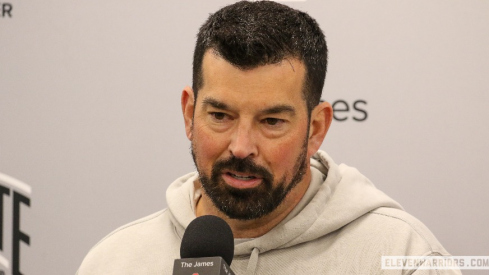
Rivalries are one of the crown jewels of college football. The pageantry and anticipation of such games have no equal in sports. The professional game has its share of contests between bitter foes, but collegiate rivalries pit towns, alumni and even families against one another. In Ohio and Alabama, house/divided signs sprinkle the landscape.
One of the sport’s great rivalry games is Oklahoma-Nebraska. The Sooners and Cornhuskers have provided college football with some of its signature games and individual performances. The 1971 game is known as the “Game of the Century” with Johnny Rodgers’ 72-yard punt return regarded as one of college football’s most indelible moments.
But the entire rivalry came crashing down with the formation of the Big 12 Conference in 1996. The teams were put in opposite divisions and only played every few years, taking a bite out of the animosity between the schools and significantly diluting the passion of the rivalry.
When the Big Ten divvied up its divisional alignment after the Cornhuskers became the conference’s 12th member, rivalry games were not a casualty. Jim Delany saw what happened in the Big 12 and vowed the same mistake would not occur to Ohio State-Michigan, Wisconsin-Minnesota and Indiana-Purdue.
The Buckeyes and Wolverines were placed in opposite divisions, but the game stayed on the schedule in sharpie for the final Saturday in November. But the inclusion of Rutgers and Maryland has realigned the divisions. Caught in the crosshairs is the Illibuck.
The game will only be played once every four years. Other schools that will have extended hiatuses from Ohio State’s schedule are the likes of Wisconsin and Iowa, teams the Buckeyes have competed against since the turn of the 20th century. Instead Ohio State will get a steady diet of Maryland and Rutgers.
“It’s change. There’s one constant in life – change,” Ohio State athletic director Gene Smith recently told Eleven Warriors. “We’re a very progressive conference. I think back to when we did the Big Ten Network, which gave me a few gray hairs. People were apprehensive and there was trepidation. That’s understandable when you’re doing something creative and there’s change. And it worked. It’s been a wild success.
“I’m always looking forward. We knew when we started expansion that there would be concerns. But we also had a focus on what we had to do to maintain the strength of our consortium, and that’s what we did. Adding Maryland and Rutgers is significant for our long-term success. That’s very important to us.”
There isn’t outrage in Columbus or Champaign about the break in the series. Ohio State-Illinois doesn’t register in the pantheon of college football rivalries. The game does have a rich history, though.
From 1919 to 1933, the game served as the regular-season finale for both schools, and for 89 consecutive years, from 1914 until 2003, the Buckeyes and Fighting Illini played each other every season. During that stretch, the game showcased the talents of Red Grange, Chic Harley, Dick Butkus, Archie Griffin and Eddie George.
What was once a competitive rivalry has turned into a one-sided affair. Ohio State leads the all-time series, 64-30-4. Starting in 1968, Ohio State beat Illinois 15 straight years. But then the Illini rattled off eight wins in 12 seasons, including a stretch of five consecutive victories during the John Cooper era. Ohio State has since rebounded, winning 13 of the past 15 games in the series. One of those losses, though, was a crushing defeat in Ohio Stadium, when the Illini beat the top-ranked Buckeyes in 2007.
Anytime you play a team every season – or for 89 straight years – there’s bound to be bad blood.
Anytime you play a team every season – or for 89 straight years – there’s bound to be bad blood. Add in bragging rights with a trophy and it reaches another level.
In 1925, Ohio State and Illinois started playing for a turtle called the Illibuck. It is the second-oldest trophy game in the Big Ten, behind Michigan and Minnesota’s Little Brown Jug. In the early years, the trophy was actually a live turtle. The symbolism was meant to represent the long life of a turtle, comparing it to the budding rivalry that would last decades. The turtle, however, only lasted two more years before its untimely demise. Now a wooden replica is used with two honorary societies housing the creature – Bucket and Dipper of Ohio State and Atius-Schaem of Illinois.
The Illibuck will enjoy an extended stay on the campuses. The shift stems from expansion, which has already delivered last rites to some of the game’s best rivalries. Texas-Texas A&M, dating to the 1800s, and West Virginia-Pitt, played for nearly 70 years, are on hold for the foreseeable future. Rivalries and traditions have all become pawns in college football’s big money game.
There’s a reason college football has long owned the title of having the best regular season in sports. There’s the possibility that one loss can severely damage one’s season. And above all, those rivalry games make the favorite quiver each fall.
The allure of a national championship now trumps all other goals. It used to be in the Big Ten that a conference championship and Rose Bowl berth would satisfy easygoing Midwestern fans. Sprinkle in a couple wins over your rival every few years and a coach could have a lifetime contract.
Not anymore. There is now an insatiable thirst for annual success. It truly is a what-have-you-done-for-me-lately generation. The best evidence is the firing of Gene Chizik less than two years removed from winning the national title at Auburn.
Lost in all the hubbub is the sport’s greatest links: rivalries and traditions.

